Photo: The Trip that Started it All
...okay, so maybe "started it all" is a bit of an overstatement...let me explain...
I grew up with photography. My father had his old Minolta or Canon out often, and I still have boxes and boxes of slides of my brothers and I growing up and all of the places we lived travelling with the military. I actually remember taking a picture for him from the top of a pagoda at Sun Moon Lake, Taiwan, because I could fit into the gap he wanted the picture taken from and he couldn't. I must have been six or seven years old at the time.
I bought my first camera, a Minolta X-500, with my first paycheck after I finished high school, and I set out to shoot as many pictures with it as I could. That camera even went with me to Air Force Basic Training, and I still use it today, when I get the urge to shoot film instead of digital.
But, growing up, no one ever told me about all the other stuff photographers are supposed to know about, like composition, and lighting, and exposure...and it seemed like no matter how hard I tried to take a great picture, I got garbage back. What was the point of spending money on a roll of film and more money to get it developed, only to see dozens of washed-out over-exposed pictures of my friends' faces, with eyes glaring red, and the tops of their heads chopped off like some lunatic tribe of b-movie Indians had rampaged through the developer's lab scalping everyone they could reach...?
I also made one of those life mistakes, and married someone who didn't appreciate my love of photography. It's very difficult to take your time and compose a shot and experiment with different settings with someone standing ten feet away, arms crossed, toe tapping, mumbling "is he done playing with that stupid thing yet...?"
End result...I might have shot five rolls of film between 1990 and 2000.
The two "D's" - divorce and digital - changed a bunch of things in my life.
Digital is a godsend to student photographers. To take better pictures, you need feedback; you need to experiment with a setting, or exposure, or pose, see how the picture turned out, and learn from the process. With 35mm, that process takes a long time--you have to finish the roll, then send it in for developing, then check the results against what you remember shooting...with me, that feedback loop often took weeks, or longer. By that time, I couldn't remember what I was trying to do in the picture.
Digital, on the other hand, shortens that feedback loop to nearly immediate. You can see the new picture in the back of the camera, and find out if you made any major errors, and reshoot immediately. Then you can download the pictures to your computer, and learn from the shoot that day, rather than waiting for the pictures to come back from the developer. And in my case...without wasting the money developing garbage.
With digital, suddenly photography was fun again.
When the company I worked for at the time announced a paid vacation trip to Whistler, in Vancouver, shortly after my divorce, I decided it was time to revive my old interest in photography. But this time, I wouldn't just be lugging around a Minolta and twenty rolls of film...I was going to take my HP Photosmart 215 and a laptop. I told myself that if I enjoyed taking pictures, I would seriously pursue it, but that if all I shot was garbage, then I would know that photography just wasn't for me.
I shot over five hundred pictures that week, and I really put that "learning photography feedback loop" through it's paces. I have no doubt that I shot at least 480 pieces of garbage, but I also set out to learn from each of them, and by the last day, I felt like I was actually shooting some pictures I would be proud to show off.
...yes, I'm doing the "vacation picture slide show" thing here, to illustrate my point about learning more quickly with digital. Do you have a problem with that...?
First shot is a creek across the street from our hotel. What I learned from this shot is "don't shoot into the sun." Oh, and "if you do shoot into the sun, you might be able to clean it up just a little bit in Photoshop." I almost threw this shot away because the flare was so bad, but a good friend convinced me to keep it.
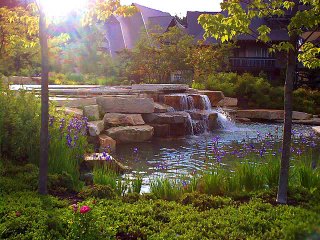
Second, I learned that sailing across a cable at fifty miles an hour is an absolute blast. This is a shot from the launching point of the ZipTrek Ecotour wire. The mountain climbing harness is attached to the wire at the top, and to me at the bottom, and ten seconds after I took this shot, I stepped off and zipped across to the other side. It's over-exposed; the river is washed out, sorry for the pun. I named this picture Apprehension, because I was trying to capture the moment, standing there with your heels firmly planted on the platform and your toes a hundred feet off the ground, working up the nerve to step out into space...
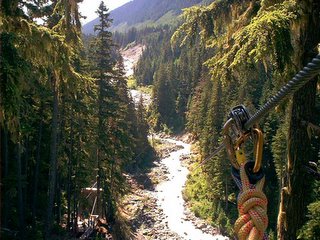
Not a great picture, but I just had to share what is quite probably the coolest piece of playground equipment I have ever seen.
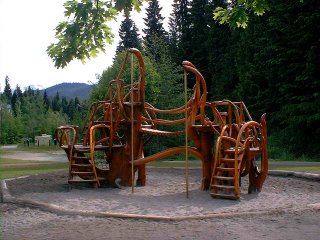
And finally, two shots of the mountains, taken from the top of Whistler mountain, on the very last day we were there.

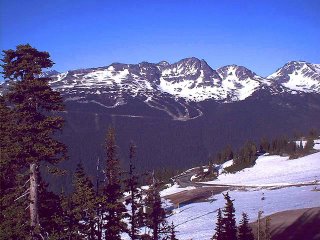
No, these are not "fantastic!" photos. They were shot with the digital equivalent of a disposeable camera; there are no controls, or options, or bells and whistles, on that camera. I couldn't change shutter speed or aperture or anything, and I'm not even sure the resolution reaches a single megapixel. Just three months later, I bought my current camera, a Canon Powershot A80--one that does have some bells and whistles to it.
But that trip was where I restarted my photography hobby, and re-dedicated myself to learning more about taking pictures, and figured out the basics of the Photography Feedback Learning Loop.
-=ad=-
I grew up with photography. My father had his old Minolta or Canon out often, and I still have boxes and boxes of slides of my brothers and I growing up and all of the places we lived travelling with the military. I actually remember taking a picture for him from the top of a pagoda at Sun Moon Lake, Taiwan, because I could fit into the gap he wanted the picture taken from and he couldn't. I must have been six or seven years old at the time.
I bought my first camera, a Minolta X-500, with my first paycheck after I finished high school, and I set out to shoot as many pictures with it as I could. That camera even went with me to Air Force Basic Training, and I still use it today, when I get the urge to shoot film instead of digital.
But, growing up, no one ever told me about all the other stuff photographers are supposed to know about, like composition, and lighting, and exposure...and it seemed like no matter how hard I tried to take a great picture, I got garbage back. What was the point of spending money on a roll of film and more money to get it developed, only to see dozens of washed-out over-exposed pictures of my friends' faces, with eyes glaring red, and the tops of their heads chopped off like some lunatic tribe of b-movie Indians had rampaged through the developer's lab scalping everyone they could reach...?
I also made one of those life mistakes, and married someone who didn't appreciate my love of photography. It's very difficult to take your time and compose a shot and experiment with different settings with someone standing ten feet away, arms crossed, toe tapping, mumbling "is he done playing with that stupid thing yet...?"
End result...I might have shot five rolls of film between 1990 and 2000.
The two "D's" - divorce and digital - changed a bunch of things in my life.
Digital is a godsend to student photographers. To take better pictures, you need feedback; you need to experiment with a setting, or exposure, or pose, see how the picture turned out, and learn from the process. With 35mm, that process takes a long time--you have to finish the roll, then send it in for developing, then check the results against what you remember shooting...with me, that feedback loop often took weeks, or longer. By that time, I couldn't remember what I was trying to do in the picture.
Digital, on the other hand, shortens that feedback loop to nearly immediate. You can see the new picture in the back of the camera, and find out if you made any major errors, and reshoot immediately. Then you can download the pictures to your computer, and learn from the shoot that day, rather than waiting for the pictures to come back from the developer. And in my case...without wasting the money developing garbage.
With digital, suddenly photography was fun again.
When the company I worked for at the time announced a paid vacation trip to Whistler, in Vancouver, shortly after my divorce, I decided it was time to revive my old interest in photography. But this time, I wouldn't just be lugging around a Minolta and twenty rolls of film...I was going to take my HP Photosmart 215 and a laptop. I told myself that if I enjoyed taking pictures, I would seriously pursue it, but that if all I shot was garbage, then I would know that photography just wasn't for me.
I shot over five hundred pictures that week, and I really put that "learning photography feedback loop" through it's paces. I have no doubt that I shot at least 480 pieces of garbage, but I also set out to learn from each of them, and by the last day, I felt like I was actually shooting some pictures I would be proud to show off.
...yes, I'm doing the "vacation picture slide show" thing here, to illustrate my point about learning more quickly with digital. Do you have a problem with that...?
First shot is a creek across the street from our hotel. What I learned from this shot is "don't shoot into the sun." Oh, and "if you do shoot into the sun, you might be able to clean it up just a little bit in Photoshop." I almost threw this shot away because the flare was so bad, but a good friend convinced me to keep it.

Second, I learned that sailing across a cable at fifty miles an hour is an absolute blast. This is a shot from the launching point of the ZipTrek Ecotour wire. The mountain climbing harness is attached to the wire at the top, and to me at the bottom, and ten seconds after I took this shot, I stepped off and zipped across to the other side. It's over-exposed; the river is washed out, sorry for the pun. I named this picture Apprehension, because I was trying to capture the moment, standing there with your heels firmly planted on the platform and your toes a hundred feet off the ground, working up the nerve to step out into space...

Not a great picture, but I just had to share what is quite probably the coolest piece of playground equipment I have ever seen.

And finally, two shots of the mountains, taken from the top of Whistler mountain, on the very last day we were there.


No, these are not "fantastic!" photos. They were shot with the digital equivalent of a disposeable camera; there are no controls, or options, or bells and whistles, on that camera. I couldn't change shutter speed or aperture or anything, and I'm not even sure the resolution reaches a single megapixel. Just three months later, I bought my current camera, a Canon Powershot A80--one that does have some bells and whistles to it.
But that trip was where I restarted my photography hobby, and re-dedicated myself to learning more about taking pictures, and figured out the basics of the Photography Feedback Learning Loop.
-=ad=-

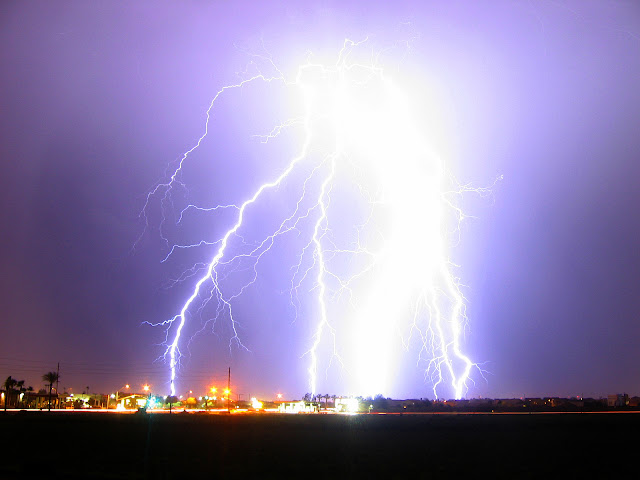
Comments